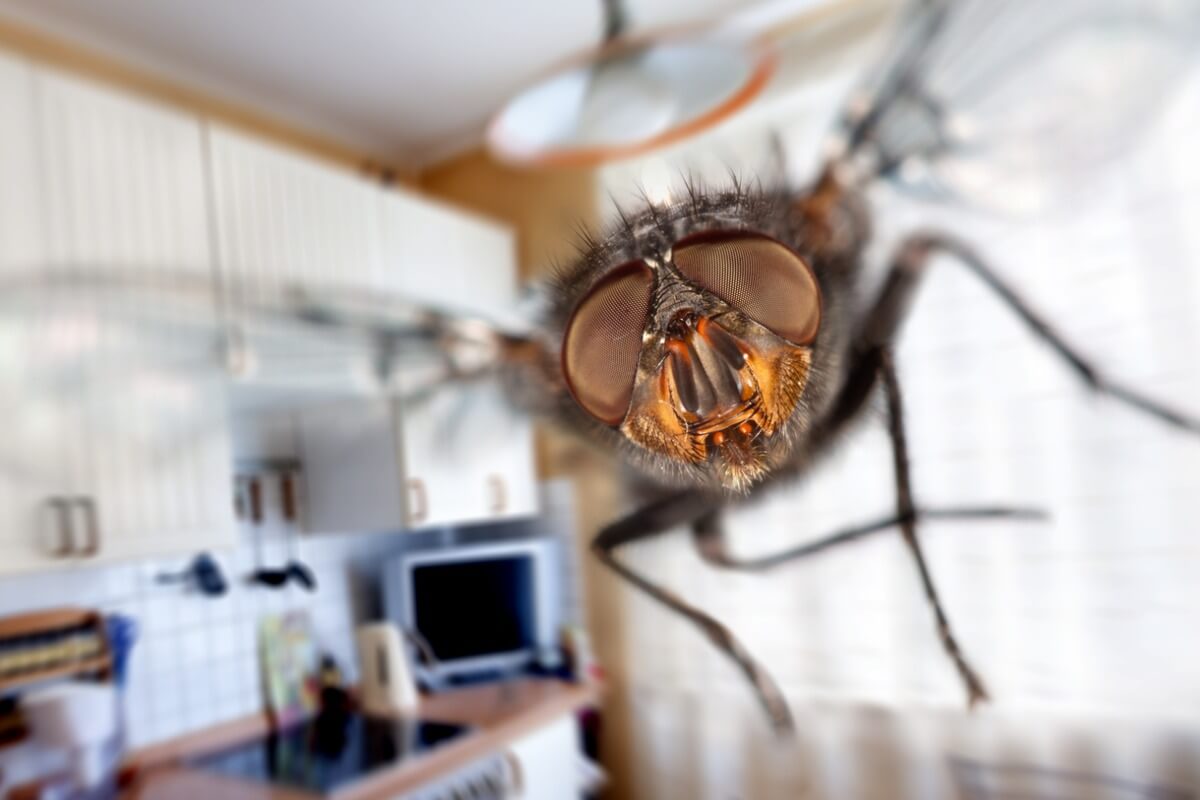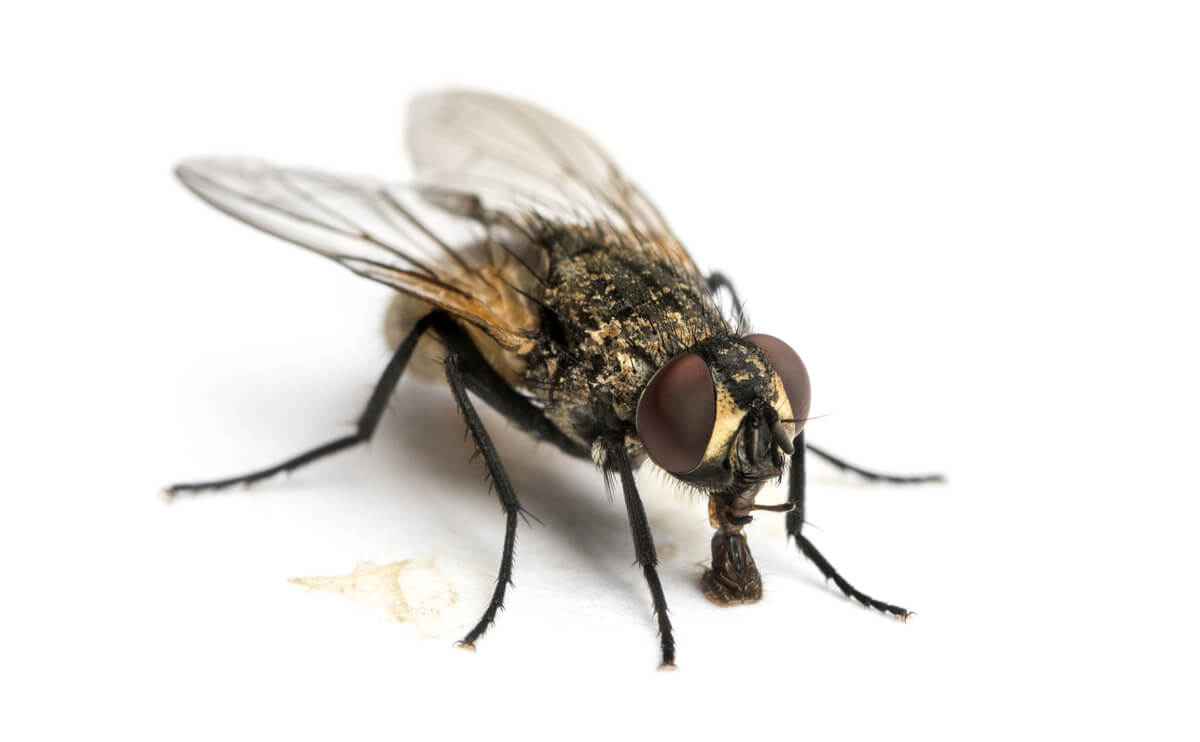What Is Fly Vision Like?

Have you ever wondered what fly vision is like? Probably when you’ve tried to kill them and they manage to escape you with ease! The fact is that they seem to be far more agile than humans, but this ability to dodge death has to do with deeper issues.
In this article, you’ll discover some facts about these invertebrates and, more interestingly, how their visual system works. Don’t miss it, because fly vision is more surprising than it seems.
Characteristics of flies
Flies are part of the family Muscidae. Their body is divided into tagma -or body segments-: the head, thorax and abdomen. Their mouth organ, on the other hand, is formed by a series of appendages, which vary according to the feeding habits of each species.
As good insects, flies have 6 legs inserted in the thorax, with their respective pads. These pads allow them to adhere to any surface at any angle.
In addition, these invertebrates have sensitive filaments all over the surface of their bodies, allowing them to smell and taste the areas where they walk. In effect, when flies scurry over your food, they are tasting the food to see if they like it.
Although some species are ovoviviparous, females typically lay their eggs near or in decaying organic matter.
Flies go through 4 stages in their development: egg, larva, pupa and adult.
These invertebrates are interesting on many levels, but fly vision is clearly one of their strengths. In the following sections, you can delve deeper with us into this question.

Types of eyes in flies
If you have ever seen a magnified image of a fly’s eyes, it’s easy to see that they’re fragmented. To be more specific, we can say that these insects have 2 eyes composed of receptive units – called ommatidia – and that they’re hexagonal. Each unit has a lens (cornea) and a layer of photoreceptor cells, the rods.
In some species, ocelli (simple eyes in the dorsal area of the head) are also associated with sight, but these are only responsible for perceiving different light intensities. Flies don’t have pupils, so they can’t regulate the amount of light reaching the retina.
There are 2 types of compound eyes according to the vision needs of flies. These are as follows:
- Apposition: Each ommatidium fixes fragments of an image, which will later be integrated into the fly’s brain. The resolution of vision increases with the size of the animal.
- Superimposition: In general, each ommatidia captures total images of the surroundings, which are superimposed when they’re integrated.
What is fly vision like?
Although it may look like it when you approach them from behind, flies don’t have a 360-degree visual range, but it’s close to it. On the other hand, when it comes to sharpness and differentiation of colors and shapes, this insect’s eyesight isn’t very well developed.
Since their food is usually dead or simply motionless, flies have no need to develop motion perception.
Even so, what’s really striking is their perception of time: according to studies, the perception of time intervals could be related to the size of the animal and its metabolic rate. Flies, compared to humans in this respect, would see time pass much more slowly.
The rate of flicker fusion in fly vision
To understand how it’s possible for time to pass more slowly for flies, we need to bear in mind that subjective time perception depends largely on the number of static images that reach the brain. In other words, the more images this organ has to integrate, the longer the film, so to speak.
The smaller the animal, the more flashes of images the retina captures per second. Specifically, humans register 60 flashes per second and flies register a whopping 250, even 400 in some species.

Even though we hate flies so much, they make us delve into such transcendental questions as the passage of time. These insects are the living demonstration that the answers aren’t only found in the stars and in large animals. The seemingly insignificant things on this planet may be the key to unlocking the secrets of life.
Have you ever wondered what fly vision is like? Probably when you’ve tried to kill them and they manage to escape you with ease! The fact is that they seem to be far more agile than humans, but this ability to dodge death has to do with deeper issues.
In this article, you’ll discover some facts about these invertebrates and, more interestingly, how their visual system works. Don’t miss it, because fly vision is more surprising than it seems.
Characteristics of flies
Flies are part of the family Muscidae. Their body is divided into tagma -or body segments-: the head, thorax and abdomen. Their mouth organ, on the other hand, is formed by a series of appendages, which vary according to the feeding habits of each species.
As good insects, flies have 6 legs inserted in the thorax, with their respective pads. These pads allow them to adhere to any surface at any angle.
In addition, these invertebrates have sensitive filaments all over the surface of their bodies, allowing them to smell and taste the areas where they walk. In effect, when flies scurry over your food, they are tasting the food to see if they like it.
Although some species are ovoviviparous, females typically lay their eggs near or in decaying organic matter.
Flies go through 4 stages in their development: egg, larva, pupa and adult.
These invertebrates are interesting on many levels, but fly vision is clearly one of their strengths. In the following sections, you can delve deeper with us into this question.

Types of eyes in flies
If you have ever seen a magnified image of a fly’s eyes, it’s easy to see that they’re fragmented. To be more specific, we can say that these insects have 2 eyes composed of receptive units – called ommatidia – and that they’re hexagonal. Each unit has a lens (cornea) and a layer of photoreceptor cells, the rods.
In some species, ocelli (simple eyes in the dorsal area of the head) are also associated with sight, but these are only responsible for perceiving different light intensities. Flies don’t have pupils, so they can’t regulate the amount of light reaching the retina.
There are 2 types of compound eyes according to the vision needs of flies. These are as follows:
- Apposition: Each ommatidium fixes fragments of an image, which will later be integrated into the fly’s brain. The resolution of vision increases with the size of the animal.
- Superimposition: In general, each ommatidia captures total images of the surroundings, which are superimposed when they’re integrated.
What is fly vision like?
Although it may look like it when you approach them from behind, flies don’t have a 360-degree visual range, but it’s close to it. On the other hand, when it comes to sharpness and differentiation of colors and shapes, this insect’s eyesight isn’t very well developed.
Since their food is usually dead or simply motionless, flies have no need to develop motion perception.
Even so, what’s really striking is their perception of time: according to studies, the perception of time intervals could be related to the size of the animal and its metabolic rate. Flies, compared to humans in this respect, would see time pass much more slowly.
The rate of flicker fusion in fly vision
To understand how it’s possible for time to pass more slowly for flies, we need to bear in mind that subjective time perception depends largely on the number of static images that reach the brain. In other words, the more images this organ has to integrate, the longer the film, so to speak.
The smaller the animal, the more flashes of images the retina captures per second. Specifically, humans register 60 flashes per second and flies register a whopping 250, even 400 in some species.

Even though we hate flies so much, they make us delve into such transcendental questions as the passage of time. These insects are the living demonstration that the answers aren’t only found in the stars and in large animals. The seemingly insignificant things on this planet may be the key to unlocking the secrets of life.
All cited sources were thoroughly reviewed by our team to ensure their quality, reliability, currency, and validity. The bibliography of this article was considered reliable and of academic or scientific accuracy.
- Metabolic rate and body size are linked with perception of temporal information. (2013, 1 octubre). ScienceDirect. https://www.sciencedirect.com/science/article/pii/S0003347213003060
- Bialek, W. & van Steveninck, R. R. (2005). Features and dimensions: Motion estimation in fly vision. arXiv preprint q-bio/0505003.
- Borst, A. (2009). Drosophila’s view on insect vision. Current biology, 19(1), R36-R47.
This text is provided for informational purposes only and does not replace consultation with a professional. If in doubt, consult your specialist.








